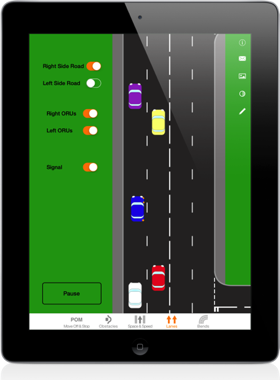
Updated and rewritten for 2022
Another topic that seems to have cropped up lately and is related to my earlier post on mobile phone use
Can Instructors (or rather supervising Drivers) hold an Ipad (or similar tablet) on the move?
(Why they’d want to I don’t know – personally I don’t use a tablet when training) –
The simple answer is NO but there are some caveats.
The law just like with normal ‘mobile phones’ says
“a mobile telephone or other device is to be treated as hand-held if it is, or must be, held at some point while being used“
So you could quite happily have it in a car mounting bracket.
You could in theory, remove the Wi-Fi and cellular chips from a tablet if fitted and just use a SD Card or something to transfer files off when you returned to base which would be legal so far as the Construction and Use Regulations are concerned.
Some people in Facebook posts etc. suggest that you can use a phone in a holder however you can’t touch it on the move or adjust the satnav on the move etc, but this has no basis in the law.
If you are not holding the device, i.e. its in a cradle then you cannot be convicted under the mobile phone legislation, the regulations detailed further down in this page clearly require the device to be held in your hand. The regulations also require the use to be only “on a road”. A distinction lost on many, as it does not include “public place”. A road may be a public place, but a public place is not automatically a road, a subject worthy of an article in itself, but at its most basic an enclosed private car park with no means of travel from A to B is unlikely to be a “road” .
However there is something else to consider.
As well as another “catch all” offence from s3 of the Road Traffic Act 1988:
“Careless, and inconsiderate, driving.
If a person drives a mechanically propelled vehicle on a road or other public place without due care and attention, or without reasonable consideration for other persons using the road or place, he is guilty of an offence.”
The section creates two offences that of careless driving and that of reasonable consideration. We are only interested in the former. Unlike the other offences however there would need to be some kind of evidence showing that the driver wasn’t demonstrating due care, such as swerving over the road etc.
Finally, there is also Section 109 of the Con and Use Regulations to consider:
109.—(1) No person shall drive, or cause or permit to be driven, a motor vehicle on a road, if the driver is in such a position as to be able to see, whether directly or by reflection, a television receiving apparatus or other cinematographic apparatus used to display anything other than information—
(a)about the state of the vehicle or its equipment.
(b)about the location of the vehicle and the road on which it is located.
(c)to assist the driver to see the road adjacent to the vehicle; or
(d)to assist the driver to reach his destination.
(2) In this regulation “television receiving apparatus” means any cathode ray tube carried on a vehicle and on which there can be displayed an image derived from a television broadcast, a recording or a camera or computer.
It’s clearly not a cathode ray tube so the section about image derived from a computer doesn’t apply.
But is it a Cinematographic apparatus?
Well ultimately that would be for a court to decide, however as Cinematography is defined as the science or art of motion-picture photography, and a static image of a test report isn’t moving. Not only that, but the police also already appear to accept that a smart phone in a cradle that can be seen by the driver doesn’t come under this offence, otherwise they’d be issuing thousands, if not millions of fixed penalties every day. Section 109 was devised to prevent the driver watching a film while driving along. The old-fashioned Cathode-Ray tube displays were constantly moving, even when displaying a static image as a consequence of how they worked, so were caught within the legislation. LED displays do not move when showing a static image, the pixel is either on or off in simple terms, so again I think it would be stretch to this to apply to them.
Lastly Examiners – Yes they are exempt from any mobile phone offence as in law they aren’t deemed to be supervising drivers when conducting a Driving Test, so for the same reason if there is a S104 offence they are also exempt.
However, they have no exemption from the S109 offence. So whatever means used such as privacy screens etc could equally be used by a supervising driver, if they had a device that was exempt.

